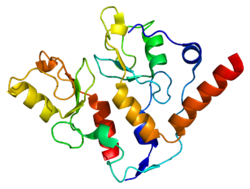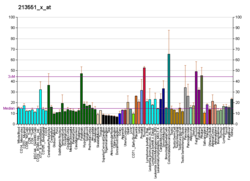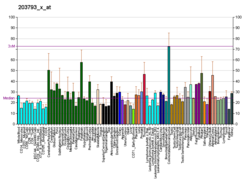Protein-coding gene in the species Homo sapiens
| PCGF2 |
|---|
 |
| Identifiers |
|---|
| Aliases | PCGF2, MEL-18, RNF110, ZNF144, polycomb group ring finger 2, TPFS |
|---|
| External IDs | OMIM: 600346; MGI: 99161; HomoloGene: 5174; GeneCards: PCGF2; OMA:PCGF2 - orthologs |
|---|
| Gene location (Human) |
|---|
 | | Chr. | Chromosome 17 (human)[1] |
|---|
| | Band | 17q12 | Start | 38,733,898 bp[1] |
|---|
| End | 38,749,817 bp[1] |
|---|
|
| Gene location (Mouse) |
|---|
 | | Chr. | Chromosome 11 (mouse)[2] |
|---|
| | Band | 11 D|11 61.06 cM | Start | 97,579,649 bp[2] |
|---|
| End | 97,591,323 bp[2] |
|---|
|
| RNA expression pattern |
|---|
| Bgee | | Human | Mouse (ortholog) |
|---|
| Top expressed in | - ganglionic eminence
- stromal cell of endometrium
- ventricular zone
- pituitary gland
- anterior pituitary
- canal of the cervix
- human kidney
- body of uterus
- left lobe of thyroid gland
- right lobe of thyroid gland
|
| | Top expressed in | - genital tubercle
- tail of embryo
- ventricular zone
- gallbladder
- superior surface of tongue
- epiblast
- neural layer of retina
- yolk sac
- plantaris muscle
- superior frontal gyrus
|
| | More reference expression data |
|
|---|
| BioGPS | 

 | | More reference expression data |
|
|---|
|
| Gene ontology |
|---|
| Molecular function | - metal ion binding
- chromatin binding
- DNA-binding transcription factor activity
- DNA binding
- protein binding
- promoter-specific chromatin binding
| | Cellular component | - nucleoplasm
- nucleus
- sex chromatin
- nuclear body
- PcG protein complex
- PRC1 complex
| | Biological process | - anterior/posterior pattern specification
- transcription, DNA-templated
- negative regulation of apoptotic signaling pathway
- embryonic skeletal system morphogenesis
- cellular response to hydrogen peroxide
- histone acetylation
- in utero embryonic development
- regulation of transcription, DNA-templated
- embryonic skeletal system development
- negative regulation of transcription by RNA polymerase II
- histone H2A-K119 monoubiquitination
- negative regulation of G0 to G1 transition
| | Sources:Amigo / QuickGO |
|
| Orthologs |
|---|
| Species | Human | Mouse |
|---|
| Entrez | | |
|---|
| Ensembl | |
|---|
ENSG00000277258
ENSG00000278644 |
| |
|---|
| UniProt | | |
|---|
| RefSeq (mRNA) | |
|---|
NM_007144
NM_001369614
NM_001369615 |
| |
|---|
NM_001163307
NM_001163308
NM_009545 |
|
|---|
| RefSeq (protein) | |
|---|
NP_009075
NP_001356543
NP_001356544 |
| |
|---|
NP_001156779
NP_001156780
NP_033571 |
|
|---|
| Location (UCSC) | Chr 17: 38.73 – 38.75 Mb | Chr 11: 97.58 – 97.59 Mb |
|---|
| PubMed search | [3] | [4] |
|---|
|
| Wikidata |
| View/Edit Human | View/Edit Mouse |
|
Polycomb group RING finger protein 2, PCGF2, also known as MEL18 or RNF110, is a protein that in humans is encoded by the PCGF2 gene.[5][6]
Function
The protein encoded by this gene contains a RING finger motif. PCGF2 is a component of the canonical PRC1 complex composed of RING1A/B, CBX2/CBX4, polyhomeotic (PHC) proteins and is very similar to the PCGF4/BMI1 containing PRC1.[7][8] Canonical PRC1 binds to chromatin via the chromodomain of the CBX subunit that recognizes the H3K27me3 mark deposited by PRC2.[9][10] Canonical PRC1 complexes have been shown to compact chromatin and mediate higher-order chromatin structures.[11][12][13]
Polycomb complexes maintain the transcription repression of genes involved in embryogenesis, cell cycles, and tumorigenesis. PCGF2 was shown to act as a negative regulator of transcription and has tumor suppressor activity. The expression of this gene was detected in various tumor cells, but is limited in neural organs in normal tissues. Knockout studies in mice suggested that this protein may negatively regulate the expression of different cytokines, chemokines, and chemokine receptors, and thus plays an important role in lymphocyte differentiation and migration, as well as in immune responses.[6]
References
- ^ a b c ENSG00000278644 GRCh38: Ensembl release 89: ENSG00000277258, ENSG00000278644 – Ensembl, May 2017
- ^ a b c GRCm38: Ensembl release 89: ENSMUSG00000018537 – Ensembl, May 2017
- ^ "Human PubMed Reference:". National Center for Biotechnology Information, U.S. National Library of Medicine.
- ^ "Mouse PubMed Reference:". National Center for Biotechnology Information, U.S. National Library of Medicine.
- ^ Ishida A, Asano H, Hasegawa M, Koseki H, Ono T, Yoshida MC, Taniguchi M, Kanno M (July 1993). "Cloning and chromosome mapping of the human Mel-18 gene which encodes a DNA-binding protein with a new 'RING-finger' motif". Gene. 129 (2): 249–55. doi:10.1016/0378-1119(93)90275-8. PMID 8325509.
- ^ a b "Entrez Gene: PCGF2 polycomb group ring finger 2".
- ^ Gao Z, Zhang J, Bonasio R, Strino F, Sawai A, Parisi F, et al. (February 2012). "PCGF homologs, CBX proteins, and RYBP define functionally distinct PRC1 family complexes". Molecular Cell. 45 (3): 344–56. doi:10.1016/j.molcel.2012.01.002. PMC 3293217. PMID 22325352.
- ^ Hauri S, Comoglio F, Seimiya M, Gerstung M, Glatter T, Hansen K, et al. (October 2016). "A High-Density Map for Navigating the Human Polycomb Complexome". Cell Reports. 17 (2): 583–595. doi:10.1016/j.celrep.2016.08.096. hdl:20.500.11850/122094. PMID 27705803.
- ^ Bernstein E, Duncan EM, Masui O, Gil J, Heard E, Allis CD (April 2006). "Mouse polycomb proteins bind differentially to methylated histone H3 and RNA and are enriched in facultative heterochromatin". Molecular and Cellular Biology. 26 (7): 2560–9. doi:10.1128/MCB.26.7.2560-2569.2006. PMC 1430336. PMID 16537902.
- ^ Cao R, Wang L, Wang H, Xia L, Erdjument-Bromage H, Tempst P, et al. (November 2002). "Role of histone H3 lysine 27 methylation in Polycomb-group silencing". Science. 298 (5595): 1039–43. Bibcode:2002Sci...298.1039C. doi:10.1126/science.1076997. PMID 12351676. S2CID 6265267.
- ^ Fursova NA, Blackledge NP, Nakayama M, Ito S, Koseki Y, Farcas AM, et al. (June 2019). "Synergy between Variant PRC1 Complexes Defines Polycomb-Mediated Gene Repression". Molecular Cell. 74 (5): 1020–1036.e8. doi:10.1016/j.molcel.2019.03.024. PMC 6561741. PMID 31029541.
- ^ Blackledge NP, Fursova NA, Kelley JR, Huseyin MK, Feldmann A, Klose RJ (February 2020). "PRC1 Catalytic Activity Is Central to Polycomb System Function". Molecular Cell. 77 (4): 857–874.e9. doi:10.1016/j.molcel.2019.12.001. PMC 7033600. PMID 31883950.
- ^ Boyle S, Flyamer IM, Williamson I, Sengupta D, Bickmore WA, Illingworth RS (July 2020). "A central role for canonical PRC1 in shaping the 3D nuclear landscape". Genes & Development. 34 (13–14): 931–949. doi:10.1101/gad.336487.120. PMC 7328521. PMID 32439634.
Further reading
- Hartley JL, Temple GF, Brasch MA (November 2000). "DNA cloning using in vitro site-specific recombination". Genome Research. 10 (11): 1788–95. doi:10.1101/gr.143000. PMC 310948. PMID 11076863.
- Wiemann S, Weil B, Wellenreuther R, Gassenhuber J, Glassl S, Ansorge W, Böcher M, Blöcker H, Bauersachs S, Blum H, Lauber J, Düsterhöft A, Beyer A, Köhrer K, Strack N, Mewes HW, Ottenwälder B, Obermaier B, Tampe J, Heubner D, Wambutt R, Korn B, Klein M, Poustka A (March 2001). "Toward a catalog of human genes and proteins: sequencing and analysis of 500 novel complete protein coding human cDNAs". Genome Research. 11 (3): 422–35. doi:10.1101/gr.GR1547R. PMC 311072. PMID 11230166.
- Kimura M, Koseki Y, Yamashita M, Watanabe N, Shimizu C, Katsumoto T, Kitamura T, Taniguchi M, Koseki H, Nakayama T (August 2001). "Regulation of Th2 cell differentiation by mel-18, a mammalian polycomb group gene". Immunity. 15 (2): 275–87. doi:10.1016/S1074-7613(01)00182-0. PMID 11520462.
- Miyazaki K, Inoue H, Onai N, Ishihara H, Kanno M (February 2002). "Chemokine-mediated thymopoiesis is regulated by a mammalian Polycomb group gene, mel-18". Immunology Letters. 80 (2): 139–43. doi:10.1016/S0165-2478(01)00315-7. PMID 11750047.
- Levine SS, Weiss A, Erdjument-Bromage H, Shao Z, Tempst P, Kingston RE (September 2002). "The core of the polycomb repressive complex is compositionally and functionally conserved in flies and humans". Molecular and Cellular Biology. 22 (17): 6070–8. doi:10.1128/MCB.22.17.6070-6078.2002. PMC 134016. PMID 12167701.
- Suzuki M, Mizutani-Koseki Y, Fujimura Y, Miyagishima H, Kaneko T, Takada Y, Akasaka T, Tanzawa H, Takihara Y, Nakano M, Masumoto H, Vidal M, Isono K, Koseki H (September 2002). "Involvement of the Polycomb-group gene Ring1B in the specification of the anterior-posterior axis in mice". Development. 129 (18): 4171–83. doi:10.1242/dev.129.18.4171. PMID 12183370.
- Matsuo F, Yano K, Saito H, Morotomi K, Kato M, Yoshimoto M, Kasumi F, Akiyama F, Sakamoto G, Miki Y (2002). "Mutation analysis of the mel-18 gene that shows decreased expression in human breast cancer cell lines". Breast Cancer. 9 (1): 33–8. doi:10.1007/BF02967544. PMID 12196719. S2CID 26605827.
- Wiemann S, Arlt D, Huber W, Wellenreuther R, Schleeger S, Mehrle A, Bechtel S, Sauermann M, Korf U, Pepperkok R, Sültmann H, Poustka A (October 2004). "From ORFeome to biology: a functional genomics pipeline". Genome Research. 14 (10B): 2136–44. doi:10.1101/gr.2576704. PMC 528930. PMID 15489336.
- Kimura K, Wakamatsu A, Suzuki Y, Ota T, Nishikawa T, Yamashita R, Yamamoto J, Sekine M, Tsuritani K, Wakaguri H, Ishii S, Sugiyama T, Saito K, Isono Y, Irie R, Kushida N, Yoneyama T, Otsuka R, Kanda K, Yokoi T, Kondo H, Wagatsuma M, Murakawa K, Ishida S, Ishibashi T, Takahashi-Fujii A, Tanase T, Nagai K, Kikuchi H, Nakai K, Isogai T, Sugano S (January 2006). "Diversification of transcriptional modulation: large-scale identification and characterization of putative alternative promoters of human genes". Genome Research. 16 (1): 55–65. doi:10.1101/gr.4039406. PMC 1356129. PMID 16344560.
- Mehrle A, Rosenfelder H, Schupp I, del Val C, Arlt D, Hahne F, Bechtel S, Simpson J, Hofmann O, Hide W, Glatting KH, Huber W, Pepperkok R, Poustka A, Wiemann S (January 2006). "The LIFEdb database in 2006". Nucleic Acids Research. 34 (Database issue): D415–8. doi:10.1093/nar/gkj139. PMC 1347501. PMID 16381901.
- Silva J, García JM, Peña C, García V, Domínguez G, Suárez D, Camacho FI, Espinosa R, Provencio M, España P, Bonilla F (December 2006). "Implication of polycomb members Bmi-1, Mel-18, and Hpc-2 in the regulation of p16INK4a, p14ARF, h-TERT, and c-Myc expression in primary breast carcinomas". Clinical Cancer Research. 12 (23): 6929–36. doi:10.1158/1078-0432.CCR-06-0788. PMID 17145810.
- Guo WJ, Datta S, Band V, Dimri GP (February 2007). "Mel-18, a polycomb group protein, regulates cell proliferation and senescence via transcriptional repression of Bmi-1 and c-Myc oncoproteins". Molecular Biology of the Cell. 18 (2): 536–46. doi:10.1091/mbc.E06-05-0447. PMC 1783768. PMID 17151361.
- Wiederschain D, Chen L, Johnson B, Bettano K, Jackson D, Taraszka J, Wang YK, Jones MD, Morrissey M, Deeds J, Mosher R, Fordjour P, Lengauer C, Benson JD (July 2007). "Contribution of polycomb homologues Bmi-1 and Mel-18 to medulloblastoma pathogenesis". Molecular and Cellular Biology. 27 (13): 4968–79. doi:10.1128/MCB.02244-06. PMC 1951487. PMID 17452456.
- Guo WJ, Zeng MS, Yadav A, Song LB, Guo BH, Band V, Dimri GP (June 2007). "Mel-18 acts as a tumor suppressor by repressing Bmi-1 expression and down-regulating Akt activity in breast cancer cells". Cancer Research. 67 (11): 5083–9. doi:10.1158/0008-5472.CAN-06-4368. PMC 2386662. PMID 17545584.
- Szafranski K, Schindler S, Taudien S, Hiller M, Huse K, Jahn N, Schreiber S, Backofen R, Platzer M (2007). "Violating the splicing rules: TG dinucleotides function as alternative 3' splice sites in U2-dependent introns". Genome Biology. 8 (8): R154. doi:10.1186/gb-2007-8-8-r154. PMC 2374985. PMID 17672918.
 | This article on a gene on human chromosome 17 is a stub. You can help Wikipedia by expanding it. |

 2h0d: Structure of a Bmi-1-Ring1B Polycomb group ubiquitin ligase complex
2h0d: Structure of a Bmi-1-Ring1B Polycomb group ubiquitin ligase complex





















